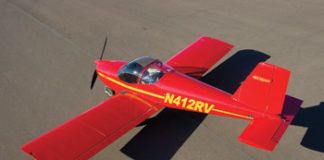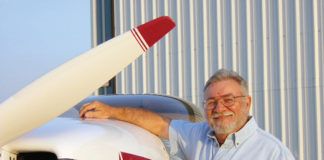At the last EAA chapter meeting, someone asked if the story was true: Had my RV-6 never traveled to a destination far enough to require an en-route fuel stop? It was. I first flew the airplane on December 26, 1993, and its been flyable for 12 of the last 14 years, accumulating just over 1000 airframe hours. But its never been farther than Sun Valley, Idaho or Carson City, Nevada-both less than 3 hours from my home near Portland, Oregon. I was up for a bit of an adventure, and I was tired of the story, so in June 2007 I flew it to Alaska.
Plus, I had a reason to go. My best friends wife had become the superintendent of the Wrangell-St. Elias National Park-a tract of land somewhat bigger than Switzerland, but with more mountains. Mike and Meg moved to Glenallen, Alaska, in December and began emailing me photos of the magnificent (but damn cold) scenery. I figured Id have to go see for myself-just as soon as it warmed up. I could either take an airliner from Portland to Anchorage for about $700 round trip, rent a car and be in Glenallen in 5 or 6 hours, or I could fly the RV-6 over 3200 miles of fairly remote landscape, spend four days traveling and burn $1000 worth of fuel at todays astronomical prices. It was a no-brainer.
Going Solo
Im not new to cross-country flying, having flown small airplanes over much of the United States as part of my job. But Id almost always had another pilot along or gone in company with one or two more airplanes. Id never tackled a trip of this magnitude completely on my own. My first dilemma was the route. Flying along the coast of British Columbia and the Alaska panhandle was considerably shorter than going inland. But my airplane has neither IFR capability nor floats, so I just couldn’t see pinning myself between the almost permanent low-pressure area in the Northern Pacific and mountains that slant down to the sea. If the weather moves in and you cant get up and over the mountains, and you cant land on the water below…well, thats not enough options for me.
I chose the traditional inland route. Thats through the Columbia Gorge, east of Portland, north to Kamloops, British Columbia, then up the Fraser River valley to Fort St. John-the starting point of the Alaska Highway that runs through British Columbia, the Yukon and into Alaska. Two of the most useful planning tools were Randall Hendersons tips for flying into Canada on EAA Chapter 105s web site, and Dan Checkoways weather web site, weathermeister.com. I also found the NavCanada web site (www.navcanada.ca) easy and useful, and discovered there are real-time weather camera images from many spots in Alaska available online.
My airplane is pretty simple. It has no attitude instruments or VOR/LOC. It does have a Garmin GPSMAP 196 on the glareshield, one Bendix/King radio, a new transponder and a glovebox. I updated the Garmin and rigged up a battery-powered Garmin Pilot 3 as a backup. I borrowed a handheld com radio, tested the transponder and filled the glovebox with Canadian and American sectional charts. After a couple of weeks of worry and compulsive weather checking, I finally had the airplane packed with the necessary survival gear and paperwork. I left work at noon on Friday, June 8 and launched from my back yard at Dietz Airpark at 1 p.m.
Clearing Customs
I was a bit nervous about the required radio work and border crossing formalities. I hadn’t filed a flight plan since the first Reagan administration, but Flight Service was right there when I called. Portland Approach assigned me a new squawk-different from the one Id been assigned when I entered the flight plan-and got a bit testy when I couldn’t get it on the new box right away. Sorry, guys, its just so bumpy I cant tune these fussy knobs. Give me a minute. After that, it was clear sailing to Kamloops, British Columbia, about 2:40 from Dietz. I landed and called Canadian Customs from the FBO.
“No need to wait for an agent,” said the voice on the other end of the line. “Heres your entry number. Keep it in the airplane and welcome to Canada, eh?” It couldn’t have been easier.
Loaded with $1.50/liter fuel, I was off to Prince George, about 1:30 north. I joined a friend in his Cherokee Six there, and we headed off as a flight of two for an hour over the mountains to Fort St. John. By dinner time I was 800 miles north of home. The next morning, the very professional weather briefer pronounced conditions perfect-clear skies and tailwinds all the way. It took almost 2 hours to get fuel. (“We don’t work on Saturdays. There’s a $75 call-out fee on weekends.”) My friend buys a lot of fuel for that Cherokee, and once he got on the line, the guy decided he could waive the call-out fee and sell me some gas at $1.62 a liter. He didn’t hurry, though.
Finally, off I went to Watson Lake, via Fort Nelson. The Alaska Highway was unmistakable, but instead of following it through the mountains west of Fort Nelson, I chose the Liard River Valley. It was a little longer, but over lower terrain, not that it mattered. If the engine quit, it would be tough finding a level spot to land in either place. Just short of entering the pattern, Whitehorse Radio gave me a call. The detour had put me about 15 minutes past my flight plan ETA, and they wanted to know if I was all right. Comforting.
Watson Lake Airport is huge, with a pilots lounge, 24-hour radio guy, campground and an immense hangar left from WW-II. During the war, hundreds of P-39s and P-63s were ferried from Bell Aircraft in New York through Great Falls, Montana, and Watson Lake to Alaska, where Russian pilots picked them up. From there, the “Ivans” flew them across the Bering Straight and another 12 time zones to the Eastern Front, where they could use them to shoot at Germans.
How they managed the navigation is beyond me. I was fairly comfortable with two GPS units in the cockpit and the Alaska Highway beneath me. Those guys had a map, a whiskey compass that was probably iffy at those latitudes, and the knowledge that Comrade Stalin wanted the airplane delivered. I don’t know if it was guts, resignation or fear, but they did it. If they got lost or had a problem, they simply disappeared into one of the worlds largest wildernesses and were eventually covered with snow. There must be a trail of broken airplanes with pilots still strapped in the seats all the way across Siberia.
Today, Watson Lake sees far fewer airplanes, but there’s a friendly woman to fill your tank and a good B&B if you’re staying the night. I wasn’t-I pushed on to Whitehorse, flying at 10,500 feet to get on top of a broken layer and stay in smooth air. After about 45 minutes, I realized that the tops of these clouds looked just like the tops of clouds everywhere else, so I dropped down to 8500 and endured the bumps. Why fly to Alaska and miss the scenery en route?
Enjoy the View
Its big, big country. A mountain range appeared off my left wingtip and stayed there for the next four hours. Peaks like sharks teeth extended as far as I could see to the south and west. Whitehorse appeared in due course. I landed, tanked up (at $1.89/liter) and headed for Northway, Alaska. The paved runway at Northway-a major entry point-was largely destroyed by an earthquake, but a shorter gravel runway is available. I used it, taxied in and waited for the U.S. Customs agent.
When he showed up, he apologized for making me wait and said nice things about my airplane. I showed him my passport, entry sticker, license, medical, airplane registration and airworthiness certificate. (Id also carried the required proof of insurance, Canadian permission to enter with an Experimental airplane, and the silly ICAO form swearing that I had applied for the radio operators license required by neither the U.S. nor Canada but supposedly necessary if you cross the border. Nobody ever asked for those.) He thanked me politely, bid me a good trip and that was that. A quick Coke and I was off across the mountains to Glenallen.
Heading across the vast plain of interior Alaska, the GPS was showing 189 knots groundspeed. I loved that, but I could see from the wind direction and orientation of the single runway ahead that I was in for an interesting landing. Indeed it was-15 gusting 25, swinging from 45 to 90 from runway heading. I did the best I could with half flaps and extra speed, but it was still all I could handle. When all the bouncing stopped, my heart restarted, the airplane was back under control, and there was Mike.
Thoughts Turn Homeward
Over the next several days, I caught my first Copper River salmon, saw some beautiful country, learned to sleep in broad daylight (it never gets dark in June at that latitude) and enjoyed the time with a close friend. Too soon, it was time to head home. Id entertained a vague idea of flying the coastal route, but the weather didn’t cooperate. It wasn’t all that great along the inland route Id used to come up, either. I left Glenallen under a 1500-foot overcast with promises of open skies to the east. About 30 miles out I was down to 900 feet and feeling the pressure. A big hole opened up above me, and-one of the joys of flying an RV-I zoomed up and 90 seconds later was on top at 2800 feet with a clear view of the mountains. After a half-hour wait for fuel and breakfast, and another hour trying to reach Canadian customs from the modern Flight Service Station on the field, I blew some of Northways gravel south and headed for Whitehorse and Watson Lake.
I had hoped to use the Trench, a river valley route straight from Watson Lake to Prince George, to cut a couple hours off the return trip. Instead, I ended up spending the night in Watson Lake. Local weather was great, but you couldn’t get anywhere. A big line of storms and clag that had been sitting in southern British Columbia for six days was still sitting. The radio guy called the B&B, and 10 minutes later Leila was at the gate to give me a ride. I got two meals, a good bed, a good book and a ride back to my airplane for $60-a great deal.
Whether the Weather
The next leg was the diciest of the trip. Getting to Fort Nelson was OK, but when I turned the corner and headed south to Fort St. John, that damned weather system was still there. I ended up hunting and pecking at 1000 to 1200 feet for an hour, always in decent visibilities (and always with the option of turning back into better weather) but dodging scud and rain showers constantly. Without the experience of the trip up and a good GPS, I wouldn’t have tried it. Finally, I made Fort St. John, where I turned base over the biggest sawmill Ive ever seen. The log dump alone was almost as big as the town. When you see that many trees piled up and the huge swaths of forest that have been clear-cut all the way across British Columbia, any doubts you have about the ability of humans to significantly alter the landscape disappear. I was dead tired and couldn’t see my way over the mountain range ahead, so I spent the night.
Next morning, early, I was at 10,500 feet, weaving through clouds and buildups as I headed over the tall rocks to Prince George. After what seemed like a long time, but was actually an hour and 10 minutes, I was in severe clear and headed to Kamloops for that cheap (relatively speaking) fuel. After that, I filed for the tiny town of Oroville, Washington, to clear customs. Many years ago Id landed in Oroville and encountered a customs agent who went out of his way to make things unpleasant. I was pleased to find him gone and a perfectly reasonable agent there to meet me. Twenty minutes later I taxied out for the last leg home and encountered the only airplane glitch of the trip. The prop control refused to move, and I couldn’t cycle the propeller. I took off anyway, and found that at cruise speeds the engine would turn 2450 rpm. I could live with that, so I headed home, thumping through the heat waves.
Mt. Adams seemed stuck in the windshield. I flew and flew and flew, but I didn’t think Id ever get past that mountain. Finally, the Columbia River showed up. I crossed it, skimmed by Mt. Hood, pointed the nose down, found the square clump of fir trees that identifies Dietz Airpark and landed. The tach showed a total time of 25.4 hours for the trip. My wife heard the engine, and ran downstairs to meet me with a big hug and a cold lemonade. Coming home is always the best part.
What Made the Trip Unique
Looking back, it wasn’t a tough flight-just long. I actually spent less time over rough mountainous terrain than I do flying from Oregon to Oshkosh. Most of the flight paralleled the biggest mountains, rather than crossing them. You can make the trip below 8000 feet, perhaps below 7000.
There were, however, several things that are different from normal cross-country flying in the lower 48. Canadas mandatory flight plans turned out to be easy. Every airport had a direct phone to NavCanada. But contacting American customs was a surprisingly difficult job. In the Yukon, cell phones don’t work, pay phones are hard to find (and often don’t work when you find them) and many of the posted numbers don’t work either. Because you must call before you cross the border, this became a real problem. A sympathetic weather briefer in Whitehorse made an unauthorized call to customs in Anchorage on my behalf. Without his help, I might have had to spend the night. Next time Ill make sure I have working phone numbers and a phone card. Customs officials on both sides of the border were polite, efficient and timely. The Americans were interested in paperwork, the Canadians wanted to know if I had any guns. (Any firearms, sir? No. Any pistols? No. Any handguns? No. Any shotguns or rifles? No…)
Probably the most striking difference is flight planning. In the U.S., I can look at a chart, pick a destination 700 miles away, and set out. If I cant reach my goal, there are plenty of other airports in between to return or divert to. Not in the Yukon. You have to plan to go all the way to your destination, find you cant land, and return all the way to your starting point because there simply isn’t another airport with fuel any closer. Its a little like flying over the ocean…there’s a point of no return. In my airplane, that meant 300 to 350 miles was as far as I was willing to plan without an intermediate airport.
Nothing Ive seen prepared me for the physical and emotional expanse of the country. You fly along feeling, at once, very small but exalted to be part of something so grand. We’ve been given a lovely planet. Im glad I spent the time in my garage building those short little wings that let me see this part of it.




